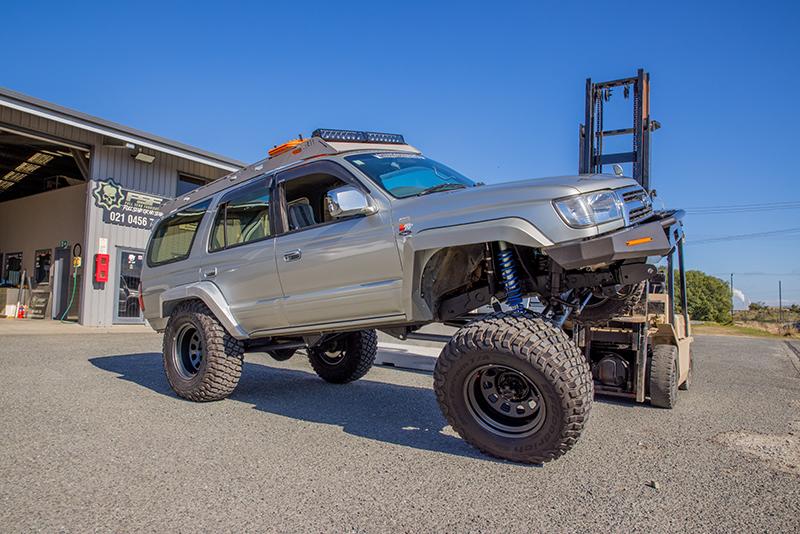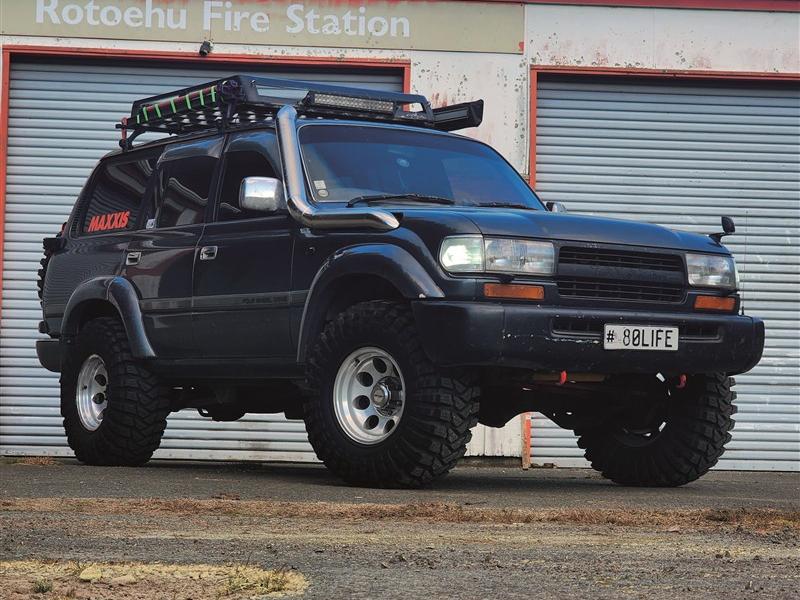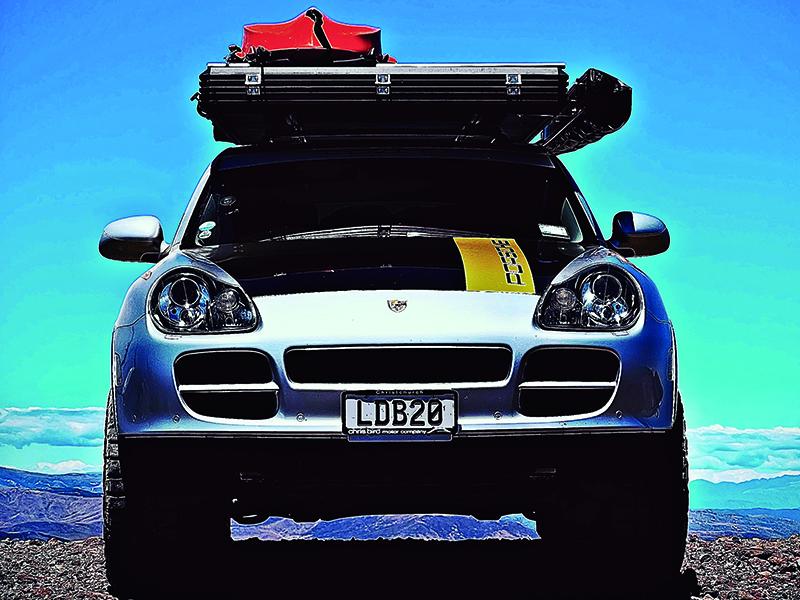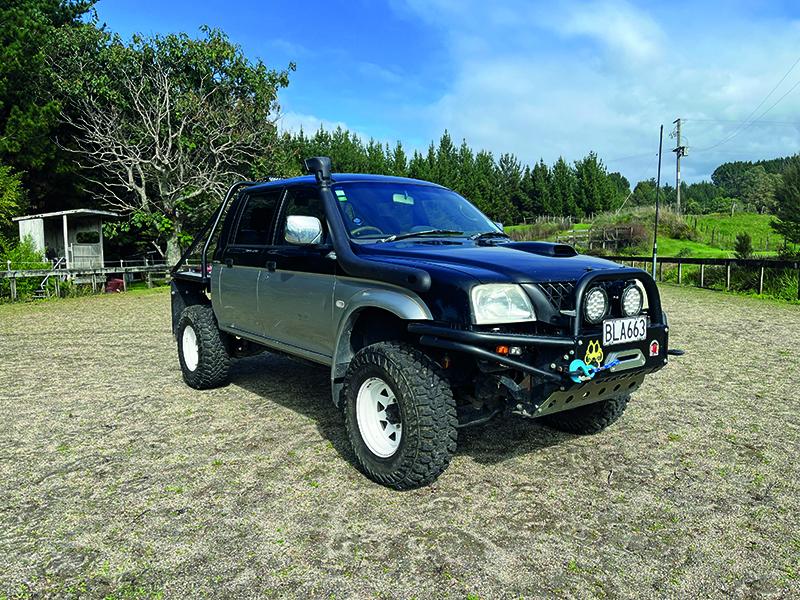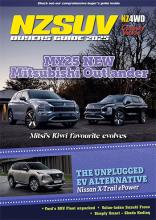Sean Goddard has always wanted to do a no-holds-barred 4WD build.
Though he was looking for a Hilux as a base to work from, he spotted this half-done Toyota Surf on TradeMe. The rest, as they say, is history.
It was purchased as an auto 2WD truck with the V8 already installed.
“The truck had been ‘converted and certed’ with rear wheel drive (only) as part of the engine conversion prior to my ownership.”
His first plan was a “full noise”
re-conversion back to 4WD with bigger shocks in the rear that came through the floor but he compromised on this to meet the legalities and make sure it could still be certed and road legal.
Sean said he had also planned to use Land Cruiser 80 Series diffs for cost reasons, but his fabricator strongly recommended Nissan GQ Patrol diffs for durability and strength
So how did the build go? A bit like that old “I’ve been everywhere” song, it went nationwide.
“I stripped the interior of the vehicle out (rear seats, door cards, carpet etc.) and put heat and sound deadening material in the cab to reduce heat and noise coming from the engine.”
The vehicle was transported to Car Tune in Tirau to sort out a modified Surf 130 transfer case to fit the Lexus transmission.
The vehicle was then transported south to Tom’s Off-Road in Canterbury for a full front and rear diff transformation including shock mounts for new 12-inch Fox remote reservoir coil-overs in the front and 10-inch Fox shocks in the rear; hydraulic bump stops, installation of a Prado fuel tank with different placement to the original Surf tank, new brake pads and rotors all round, four new crossmembers for the chassis, reinforcing, rebuilding and installation of those GQ Safari diffs, fabrication of a custom three-link front and custom four-link rear suspension set-up, heavy duty Panhard bars, and a full respray of the chassis.
Next, the Surf went to Probuilt Fabrication in Canterbury for the custom aluminium wide body to fit the wider diffs and 35-inch mud tyres on a -44 offset.
The vehicle then came back to the North Island to get the exhaust built, shocks put in and tyres fitted and remained in Auckland over the Christmas/New Year period.
After the holiday period it headed off down to Full Send Fabrication in Taupo for final detail finishing and low volume certification. Finishing touches included a custom Wilwood handbrake set-up that required out sourced modification of the original handbrake cable; shock tuning to decrease body roll; stripping and X-ray of key welds to meet certification requirements.
Since then, Sean’s mates have stepped in to make the truck truly special.
Dion Hemi Hough custom-built the bull bar while a custom aluminium roof tray was created by another local mate, Campbell Pryce.
Next, Sean plans to add a Haltech IC7 data display, which gives the driver 14 channels of information and a customisable display. It interacts through a CAN-BUS system with Haltech’s 2500 ECU. Usefully in a 4WD, the set-up has an IP54 water resistance rating.
The Surf build is freshly finished, now Sean says it’s time to take the truck out for a shakedown and some fun. The full build has been documented on Sean’s Instagram page,
@weekendwarriors4x4.
A word about that V8 motor
And that engine? It’s a generation 2 1UZ-FE Lexus V8. Sean says it’s currently stock and making 191kW (just under 300bhp). That is likely to change: he plans to do cams, valve springs and injectors when it’s legal “and also get it a good tune”. The goal is to push the power up to 298kW (400bhp).
That’s a significant increase, but well within the capabilities of one of the Toyota/Lexus stable’s finest V8s.
The 4.0-litre all-alloy double overhead cam engine arrived in 1989, fitted to the first generation Lexus LS 400/Toyota Celsior. The engine is ‘oversquare’ by design, with a bore and stroke size of 87.5mm × 82.5mm.
In production vehicles and motorsport applications it has proven to be a strong, reliable and smooth powerplant with features such as 6-bolt main bearings and belt-driven quad-camshafts. The water pump is also driven by the cambelt.
A vice president of TRD USA, David Currier (in an interview with v-eight.com) confirmed what many enthusiasts had long believed: the 1UZ platform was based on CART/IRL engine design.
In 1997, Toyota added its VVT-I variable valve timing technology and raised compression to 10.5:1 for the second generation. This delivered the stock 216kW at 5,900 rpm and 407Nm at 4,100 rpm.
The 1UZ-FE was voted onto the Ward’s 10 Best Engine list from 1998-2000. There is even a derivative that is FAA-approved in the USA for use in aircraft.

